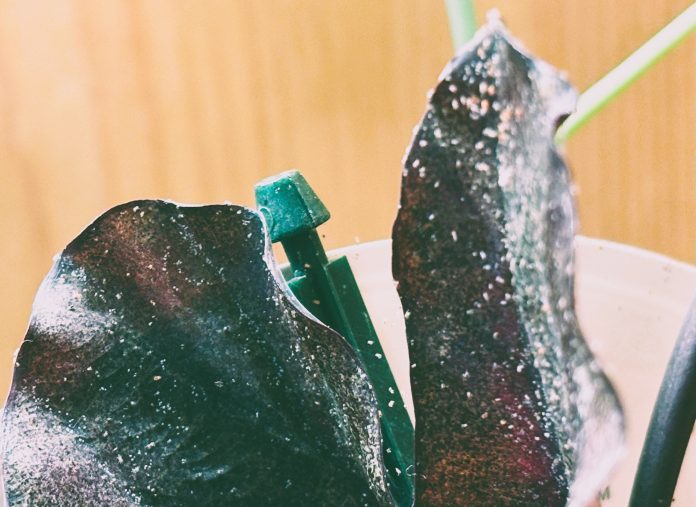Today, we’re tackling the notorious red spider mites, but with a twist. Whether you’re dealing with an infestation in your greenhouse or on your indoor houseplants, we’ve got you covered. We’ll discuss how to spot them, how to control them, and the differences in approach between indoor environments and greenhouses.
What Are Red Spider Mites?
First, what exactly are red spider mites? These tiny arachnids (Tetranychus urticae) are related to spiders and ticks, and they can do serious damage to your plants by feeding on plant cells. When mites pierce the leaves and suck out the contents, it leaves behind speckled, yellowing patches, and in severe cases, the leaves can dry up and drop off.
They’re especially problematic in hot, dry conditions, making them common in greenhouses during summer or heated indoor spaces. Because they’re so small—barely half a millimeter—you often don’t notice them until their numbers grow.
One early sign of a spider mite problem is the fine webbing they leave behind on leaves, especially on the undersides. If you spot this webbing, it’s time to act fast!
Greenhouse Infestations – A Breeding Ground for Spider Mites
Let’s start with the greenhouse scenario, which is a prime breeding ground for red spider mites. In a greenhouse, conditions are typically warm and dry—the perfect environment for these mites to thrive. They spread quickly, and if left unchecked, they can damage entire crops.
Here are some practical ways to control and prevent spider mite infestations in your greenhouse:
Monitor Conditions
In a greenhouse, climate control is key. Spider mites thrive in hot, dry environments, so controlling temperature and humidity is essential. Keeping humidity levels up (around 60% or higher) makes life difficult for spider mites. You can do this by:
- Misting plants regularly.
- Using a humidifier to increase moisture in the air.
- Ensuring good air circulation with fans.
Regular inspections are a must. Check both the tops and undersides of leaves frequently, and pay close attention to any early signs of infestation—like yellowing leaves or that telltale webbing.
Biological Control in Greenhouses
Introducing beneficial predators is one of the most effective ways to manage spider mites in a greenhouse. Since greenhouses are enclosed spaces, releasing natural enemies of spider mites can work wonders.
- Phytoseiulus persimilis: These predatory mites are highly effective at reducing spider mite populations. They thrive in similar conditions, making them an ideal solution for greenhouses. Releasing P. persimilis early in the infestation can help control the mite population quickly.
- Amblyseius californicus: Another great predator, these mites are more tolerant of varying humidity levels and can even survive on pollen when spider mites are scarce. This makes them a good long-term solution, especially in greenhouses with changing conditions.
- Ladybugs and Lacewings: Ladybugs and lacewings are generalist predators, and they’re great for keeping a wide range of pests in check, including spider mites. Releasing these insects in your greenhouse provides an eco-friendly way to manage pest problems without using chemicals.
Remember to release predators early and in sufficient quantities. Predatory mites like P. persimilis and A. californicus need time to establish themselves before the spider mite population gets too large.
Physical Barriers and Environmental Adjustments
Creating barriers, such as fine mesh screens, can help reduce the chances of spider mites entering your greenhouse in the first place. Regularly cleaning the greenhouse, removing any plant debris, and disinfecting equipment can also reduce the chances of infestation.
If you spot spider mites, you can also remove and isolate affected plants to prevent the spread. Some greenhouse owners opt for a “quarantine” zone to deal with infected plants.
Spider Mites on Indoor Houseplants – A Different Challenge
Now, let’s talk about when you find spider mites on your indoor plants. Indoor environments pose unique challenges, especially since houseplants often don’t get the benefit of natural predators. But don’t worry, there are effective solutions to keep your plants healthy.
Early Detection and Physical Removal
For indoor plants, keeping an eye on them is crucial, as spider mites can go unnoticed for a while. Regularly inspecting the tops and undersides of the leaves will help you catch infestations early.
One of the simplest methods to control mites on houseplants is by physically removing them:
- Rinse your plants: Take your plants to the sink or shower and give them a thorough rinse, focusing on the undersides of the leaves. The strong spray of water dislodges the mites, and you can do this every few days until the infestation is under control.
- Wipe the leaves: For smaller plants, you can also use a damp cloth to wipe down the leaves and remove mites. Be sure to be gentle so as not to damage delicate plants.
Controlling Humidity Indoors
Spider mites love dry conditions, which means many indoor plants, especially those near heaters or in centrally heated homes, are at risk during colder months. Increasing humidity is one way to combat this:
- Misting your plants: Regular misting helps increase moisture on the leaves and creates a less hospitable environment for spider mites.
- Use a humidifier: If you have a collection of houseplants, placing a humidifier nearby will boost the overall humidity, making it harder for mites to thrive.
You can also group plants together to create a micro-humid environment, which further helps in preventing spider mites from taking hold.
Biological Controls Indoors
Biological control indoors is a bit more challenging than in a greenhouse, but it’s still possible. While introducing large quantities of predatory mites may not be practical in a small indoor space, there are still some natural solutions you can try:
- Amblyseius californicus: These mites work well indoors because they can survive on pollen when spider mites aren’t available. They’re small enough that you can introduce a few into your indoor environment without disrupting the natural balance too much.
- Release ladybugs (carefully): While ladybugs can also be released indoors, they may not stay in one place for long. If you do decide to use them, releasing them in a controlled space like a conservatory or sunroom may yield better results.
4. Preventive Care and Isolation
When it comes to indoor plants, prevention is your best weapon. Keep your plants healthy by watering them properly and maintaining their preferred environment. Avoid placing plants in areas where conditions can become too dry, such as near heaters or radiators.
If you discover mites on one plant, isolate it from the rest to prevent the infestation from spreading. You can even create a mini quarantine zone to monitor and treat the affected plant separately.
Long-Term Monitoring and Maintenance
Whether in your greenhouse or indoors, once you’ve dealt with a spider mite infestation, it’s important to stay vigilant. Keep inspecting your plants regularly, maintain humidity levels, and consider using biological controls as a preventive measure, particularly in the greenhouse.
Indoors, keeping your plants well-watered and ensuring they’re not in overly dry conditions will reduce the likelihood of mites returning. Quarantining new plants before introducing them to your collection can also help prevent spider mites from hitching a ride into your home.
Closing Thoughts
Red spider mites may be small, but with the right strategies for your specific environment, you can keep them under control and protect your beloved plants from harm. Whether you’re facing them in a greenhouse or on your indoor plants, early detection and a combination of preventive measures will help you stay ahead of these tiny invaders. Thanks for tuning into this episode of Local Gardener. Be sure to subscribe for more tips on keeping your garden and indoor plants healthy.
Until next time, keep growing, keep learning, and happy planting!




